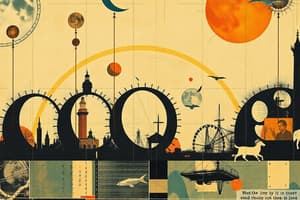Podcast
Questions and Answers
Match the artist with their contribution to incorporating the Fibonacci sequence in art:
Match the artist with their contribution to incorporating the Fibonacci sequence in art:
Leonardo da Vinci = Created illustrations showcasing the Fibonacci sequence Andrew Sutton = Created abstract artworks inspired by the Fibonacci sequence Vincent van Gogh = Used the Golden Ratio in his paintings Pablo Picasso = Incorporated symmetry and patterns in his artwork
Match the concept with its significance in art:
Match the concept with its significance in art:
Patterns = Fundamental for creating visually pleasing compositions Symmetry = Key in exploring ideas in various artistic mediums Golden Ratio = Adds aesthetics and elegance to structures Fibonacci Spiral = Inspiration for artists to create work
Match the structure with its connection to the Fibonacci sequence:
Match the structure with its connection to the Fibonacci sequence:
Spirals in nature = Reflects the Fibonacci spiral pattern Columns in architecture = Designed based on the Golden Ratio Abstract art compositions = Inspired by patterns and symmetry Web design layouts = Incorporate mathematical sequences
Match the description with its relation to art and mathematics:
Match the description with its relation to art and mathematics:
Match the medium with its utilization of mathematical concepts:
Match the medium with its utilization of mathematical concepts:
Study Notes
Exploring the Numerical Puzzle: 123's Connection to Art
The seemingly innocuous trio of numbers, 123, might not immediately evoke the world of art. However, upon closer inspection, this simple sequence has captivated artists and mathematicians alike, leading to intriguing pieces that intertwine numbers and visual creativity.
Number Sequence as Inspiration
Artists often draw inspiration from the world around them, and in the realm of mathematics, sequences and patterns offer a rich source of inspiration. The number sequence 123, for instance, can be represented by the Fibonacci sequence when starting with the first three numbers: 1, 2, and 3. This sequence, where each number is the sum of the two previous ones, is found in nature and has long been a source of fascination for artists.
Golden Ratio and Art
The Fibonacci sequence's relationship to the Golden Ratio, which is approximately 1.618, is another intriguing aspect of the 123 sequence. The Golden Ratio appears often in art, design, and architecture, as it is considered to be aesthetically pleasing. For example, in ancient Greek architecture, the Golden Ratio related to proportions in the Parthenon's columns and the dimensions of the building itself, creating a visual harmony.
Architecture and Engineering
The 123 sequence plays a role in architecture and engineering, particularly in designing structures and patterns. The Golden Ratio, which is inherent in the sequence, is used in designing spirals, columns, and even entire buildings, adding to the overall aesthetics and elegance of the structure.
Artists Using 123 as Inspiration
Artists have been drawn to the 123 sequence and its related concepts for centuries. Leonardo da Vinci, an Italian polymath and artist, created illustrations showcasing the Fibonacci sequence, demonstrating the numerical sequence's relevance to art.
More recently, contemporary artists like Andrew Sutton have created abstract artworks inspired by the Fibonacci sequence, demonstrating how the numbers can serve as a springboard for creative expression.
Patterns, Symmetry, and Art
The 123 sequence embodies patterns and symmetry, which are fundamental concepts in both mathematics and art. Artists often employ such concepts to create visually pleasing compositions, and the 123 sequence offers a unique way to explore these ideas in various mediums, from painting to sculpture.
The Fibonacci Spiral
The Fibonacci sequence and the Golden Ratio are inextricably linked to the Fibonacci spiral, a natural pattern found in various plant structures (such as the arrangement of leaves and the shape of pinecones). The spiral is a visual manifestation of the sequence, and artists have been inspired by it to create their work.
Conclusion
The exploration of the 123 sequence and its related concepts in art and design can be a fascinating endeavor. The sequence's connection to the Golden Ratio and its appearance in nature offer artists a unique way to explore patterns, symmetry, and other fundamental concepts. By understanding the 123 sequence, artists can push the boundaries of their creative expression, resulting in works that are both visually stunning and mathematically inspired.
Studying That Suits You
Use AI to generate personalized quizzes and flashcards to suit your learning preferences.
Description
Discover how the number sequence 123 is intricately connected to art through concepts like the Fibonacci sequence, the Golden Ratio, and patterns in nature. Explore how artists and mathematicians have drawn inspiration from this numerical puzzle to create visually captivating works.





